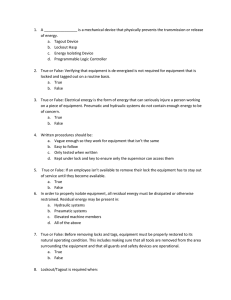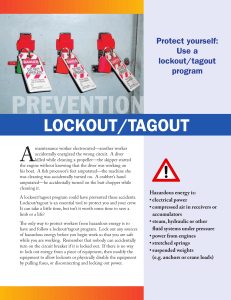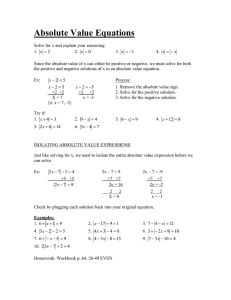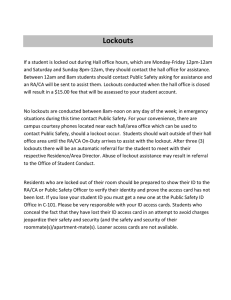In this Part "control system isolating device" means a device that
advertisement
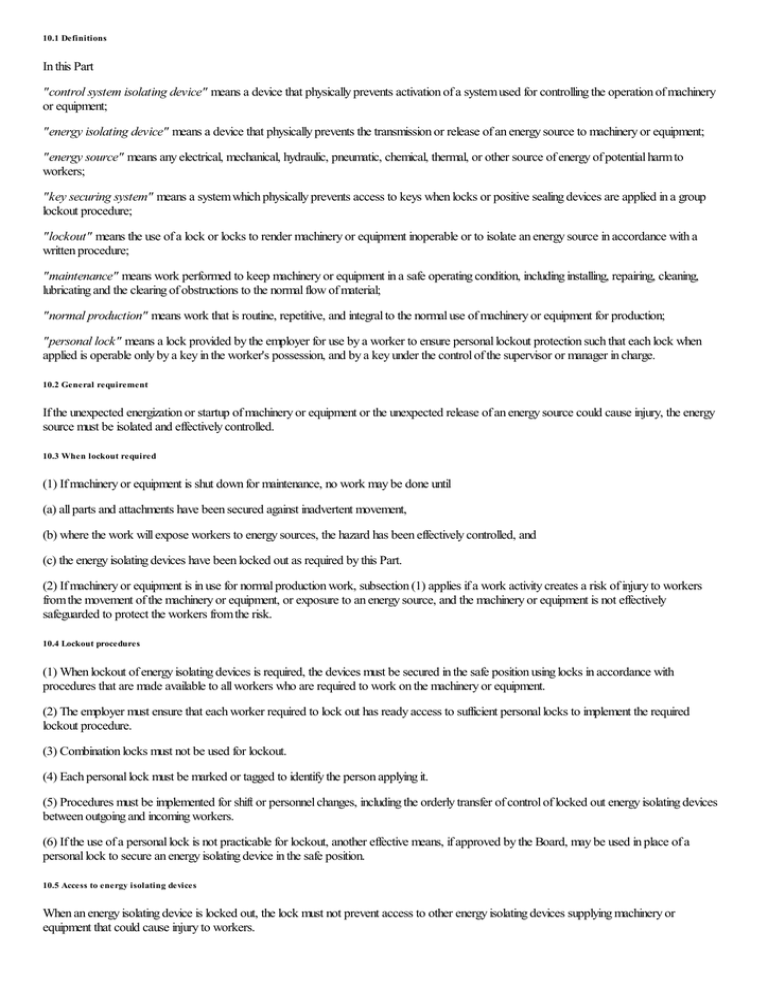
10.1 Definitions In this Part "control system isolating device" means a device that physically prevents activation of a system used for controlling the operation of machinery or equipment; "energy isolating device" means a device that physically prevents the transmission or release of an energy source to machinery or equipment; "energy source" means any electrical, mechanical, hydraulic, pneumatic, chemical, thermal, or other source of energy of potential harm to workers; "key securing system" means a system which physically prevents access to keys when locks or positive sealing devices are applied in a group lockout procedure; "lockout" means the use of a lock or locks to render machinery or equipment inoperable or to isolate an energy source in accordance with a written procedure; "maintenance" means work performed to keep machinery or equipment in a safe operating condition, including installing, repairing, cleaning, lubricating and the clearing of obstructions to the normal flow of material; "normal production" means work that is routine, repetitive, and integral to the normal use of machinery or equipment for production; "personal lock" means a lock provided by the employer for use by a worker to ensure personal lockout protection such that each lock when applied is operable only by a key in the worker's possession, and by a key under the control of the supervisor or manager in charge. 10.2 General requirement If the unexpected energization or startup of machinery or equipment or the unexpected release of an energy source could cause injury, the energy source must be isolated and effectively controlled. 10.3 When lockout required (1) If machinery or equipment is shut down for maintenance, no work may be done until (a) all parts and attachments have been secured against inadvertent movement, (b) where the work will expose workers to energy sources, the hazard has been effectively controlled, and (c) the energy isolating devices have been locked out as required by this Part. (2) If machinery or equipment is in use for normal production work, subsection (1) applies if a work activity creates a risk of injury to workers from the movement of the machinery or equipment, or exposure to an energy source, and the machinery or equipment is not effectively safeguarded to protect the workers from the risk. 10.4 Lockout procedures (1) When lockout of energy isolating devices is required, the devices must be secured in the safe position using locks in accordance with procedures that are made available to all workers who are required to work on the machinery or equipment. (2) The employer must ensure that each worker required to lock out has ready access to sufficient personal locks to implement the required lockout procedure. (3) Combination locks must not be used for lockout. (4) Each personal lock must be marked or tagged to identify the person applying it. (5) Procedures must be implemented for shift or personnel changes, including the orderly transfer of control of locked out energy isolating devices between outgoing and incoming workers. (6) If the use of a personal lock is not practicable for lockout, another effective means, if approved by the Board, may be used in place of a personal lock to secure an energy isolating device in the safe position. 10.5 Access to energy isolating devices When an energy isolating device is locked out, the lock must not prevent access to other energy isolating devices supplying machinery or equipment that could cause injury to workers. 10.6 Checking locked out equipment (1) Effective means of verifying lockout must be provided and used. (2) Before commencing work, a worker must verify that all energy sources have been effectively locked out. 10.7 Worker responsibilities Each worker who works on machinery or equipment requiring lockout is responsible for (a) locking out the energy isolating devices before starting work, except as provided by section 10.9, (b) removing personal locks on the completion of his or her work, and (c) maintaining immediate control of the key(s) to personal locks throughout the duration of the work. 10.8 Removal of locks (1) A personal lock must only be removed by the worker who installed it, or if this is not possible, the matter must be referred to the supervisor or manager in charge, who will be responsible for its removal. (2) The supervisor or manager in charge must (a) make every reasonable effort to contact the worker who installed the lock, and (b) ensure that the machinery or equipment can be operated safely before removing the lock. (3) A worker must be notified at the start of his or her next shift if the worker's personal lock(s) have been removed since the worker's previous shift. 10.9 Group lockout procedure (1) If a large number of workers are working on machinery or equipment or a large number of energy isolating devices must be locked out, a group lockout procedure that meets the requirements of subsections (2) to (7) may be used. (2) In a group lockout procedure 2 qualified workers must be responsible for (a) independently locking out the energy isolating devices, (b) securing the keys for the locks used under paragraph (a) with personal locks or other positive sealing devices acceptable to the Board, and (c) completing, signing and posting a checklist that identifies the machinery or equipment components covered by the lockout. (3) Before commencing work each worker working on the locked out components must apply a personal lock to the key securing system used in subsection (2)(b). (4) Workers may lock out a secondary key securing system if 2 qualified workers lock out the primary key securing system and place their keys in the secondary system. (5) On completion of his or her work, each worker referred to in subsections (3) and (4) must remove his or her personal lock from the key securing system. (6) When the requirements of subsection (5) have been met and it has been determined that it is safe to end the group lockout, 2 qualified workers must be responsible for removing their personal locks or the positive sealing device(s) from the key securing system or systems containing the keys for the locks used under subsection (2)(a), and once those keys are released, the system is no longer considered to be locked out. (7) The written group lockout procedure must be conspicuously posted at the place where the system is in use. 10.10 Alternative procedures (1) If lockout of energy isolating devices as required by section 10.3 is not practicable, (a) in the case of a power system as defined in Part 19 (Electrical Safety), the requirements of that Part must be followed, (b) in the case of mobile equipment as defined in Part 16 (Mobile Equipment), the requirements of that Part must be followed, (c) in the case of machinery or equipment designed and equipped with effective control system isolating devices, the devices must be locked out as required by sections 10.4 to 10.9, and 10.10(2), and (d) in an emergency, the energy isolating devices or control system devices must be effectively controlled to prevent inadvertent start up or hazardous energy release. (2) Control system isolating devices and the procedures for using them must be approved in writing by the Board, and must be used by workers qualified and authorized to carry out the work. 10.11 Locks not required The application of a lock is not required under section 10.3 or 10.10 if (a) the energy isolating device is under the exclusive and immediate control of the worker at all times while working on the machinery or equipment, or (b) a tool, machine or piece of equipment which receives power through a readily disconnected supply, such as an electrical cord or quick release air or hydraulic line, is disconnected from its power supply and its connection point is kept under the immediate control of the worker at all times while work is being done. 10.12 Work on energized equipment If it is not practicable to shut down machinery or equipment for maintenance, only the parts which are vital to the process may remain energized and the work must be performed by workers who (a) are qualified to do the work, (b) have been authorized by the employer to do the work, and (c) have been provided with and follow written safe work procedures. Back to Top 10.1 Definitions 10.2 General requirement 10.3 When lockout required 10.4 Lockout procedures 10.5 Access to energy isolating devices 10.6 Checking locked out equipment 10.7 Worker responsibilities 10.8 Removal of locks 10.9 Group lockout procedure 10.10 Alternative procedures 10.11 Locks not required 10.12 Work on energized equipment
